 |
 |
|
New Orleans Mardi Gras
Websites
New Orleans Mardi Gras Guides
Mardi Gras King Cakes
Mardi Gras Krewes and Parades
Mardi Gras Live Cams
Mardi Gras Shopping
|
|
|
New Orleans Lodging
Over 200 New Orleans area websites for lodging from hotels and bed and breakfasts in the French Quarter to hotels and motels in the nearby suburbs.
Go to New Orleans Hotels
Go to New Orleans Bed and Breakfasts
More New Orleans websites for Tourists
Go to: Tours, Arts, Entertainment, Restaurants, Bars, Clubs & Pubs, Festivals, Music, Casinos
|
|
|
Mardi Gras Live Cams
SEE ALL
Bourbon Street on Mardi Gras
On Mardi Gras Day, everyone wants to see live cams of New Orleans. We’ve collected links to live cams throughout New Orleans but the most popular live cams by far are the Mardi Gras live cams in the French Quarter. Several hotels, bars and restaurants in the French Quarter provide live cams of Bourbon Street on Mardi Gras day. Some live cams are only online during Mardi Gras season. Browse through the live cam links we’ve collected and find your favorites. It’s a great way to gauge the crowds during the entire Mardi Gras season or just enjoy the craziness going on each Mardi Gras from the comfort of your home computer.
Live Cams on Bourbon Street! Come join the fun and see what's happening! We've got the French Quarter covered with live Mardi Gras Cams up and down Bourbon Street.
Go to Mardi Gras Live Cams
|
|
|
Mardi Gras King Cakes
SEE ALL
Mardi Gras King Cake
Right after New Years, Mardi Gras king cakes begin appearing in supermarkets and bakeries around New Orleans. The circular cake with purple, green and gold colored icing or sugar is the New Orleans version of a Catholic tradition dating back hundreds of years. The king cake or ‘kings’ cake’ as its known in France and Spanish speaking countries, is named for the biblical three kings (the three wise men) who visit the infant Jesus. According to Catholic tradition, the tree kings took 12 days to reach Bethlehem (the 12 days of Christmas). King Cake season in New Orleans officialy begins twelve days after Christmas and goes to Mardi Gras day.
King cakes have been eaten in New Orleans since the 1700s. King cake parties have been documented in New Orleans from the French colonial period. Traditional king cakes contain a small plastic baby (said to represent the baby Jesus) inside the cake. Before the 1950s, the baby was made of porcelan. In other countries it may be a bean or other small trinket. By tradition, whoever gets the slice of cake with the baby or trinket inside is declared king or queen for the day and has certain obligations such as preparing a traditional meal for others to enjoy. In New Orleans, whoever finds the baby inside their slice of king cake is obligated to bring a king cake to the next king cake party or gathering. Today, king cakes often show up during Carnival season at work, school or small social gatherings where fellow employees, students and friends share a king cake knowing that whoever gets the baby will bring the king cake to the next event.
Today there are many delicious varieties of King Cakes in New Orleans. The traditional baked ring of twisted bread is now often filled with a variety of fillings from cream cheese to pralines. Also popular in New Orleans are the deep fried Cajun king cake. New Orleans king cakes are almost always topped with sugar or frosting in the traditional Mardi Gras colors of purple, green and gold.
Go to Mardi Gras King Cakes
 |
|
|
|
Best Mardi Gras Websites - SEE ALL
Check out the best Mardi Gras Guides for Parade Schedules and Routes! Everyone wants to know the parade schedules and 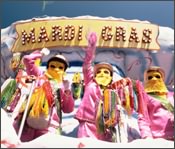 parade routes. There are many New Orleans Mardi Gras guide web sites that specialize in providing the annual Mardi Gras parade schedules as well as lots of other valuable and entertaining information about Mardi Gras in New Orleans. You’ll find information on the long history and the fascinating traditions of Mardi Gras, tips and FAQs that will help you better enjoy Mardi Gras and information on Mardi Gras Krewes and their secretive Mardi Gras balls. Many New Orleans Mardi Gras guides have photos and videos of Mardi Gras parades and celebrations as well as links to live Mardi Gras video cams. You can learn about Mardi Gras king cakes and even order king cakes and popular Mardi Gras beads and other throws on their websites. parade routes. There are many New Orleans Mardi Gras guide web sites that specialize in providing the annual Mardi Gras parade schedules as well as lots of other valuable and entertaining information about Mardi Gras in New Orleans. You’ll find information on the long history and the fascinating traditions of Mardi Gras, tips and FAQs that will help you better enjoy Mardi Gras and information on Mardi Gras Krewes and their secretive Mardi Gras balls. Many New Orleans Mardi Gras guides have photos and videos of Mardi Gras parades and celebrations as well as links to live Mardi Gras video cams. You can learn about Mardi Gras king cakes and even order king cakes and popular Mardi Gras beads and other throws on their websites.
For Mardi Gras Parade Schedules, Parade Routes and more, we've collected the very  best New Orleans Mardi Gras guides on the internet! We’ve also included websites with interesting information about the culture of Mardi Gras in New Orleans such as Mardi Gras museums and Mardi Gras Indians. best New Orleans Mardi Gras guides on the internet! We’ve also included websites with interesting information about the culture of Mardi Gras in New Orleans such as Mardi Gras museums and Mardi Gras Indians.
Go to New Orleans Mardi Gras Guides
 |
|
|
|
Mardi Gras Shopping - SEE ALL
Stock up on Mardi Gras throws! If you just can’t catch enough of those extra long purple, green and gold Mardi Gras beads, shop for them easily online. All the 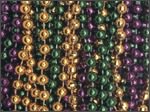 largest suppliers of Mardi Gras beads and throws are online as well as many smaller suppliers that often have unique Mardi Gras specialties and novelties. If you’re throwing a Mardi Gras party you can shop online for Mardi Gras masks and Mardi Gras decorations. Purple, green and gold Mardi Gras flags are a popular online item as well as Mardi Gras gear including hats, caps and shirts. From beads and doubloons to elaborate feathered masks and Mardi Gras dolls, browse, buy online or find out what's the latest in Mardi Gras throws, souvenirs and curios. largest suppliers of Mardi Gras beads and throws are online as well as many smaller suppliers that often have unique Mardi Gras specialties and novelties. If you’re throwing a Mardi Gras party you can shop online for Mardi Gras masks and Mardi Gras decorations. Purple, green and gold Mardi Gras flags are a popular online item as well as Mardi Gras gear including hats, caps and shirts. From beads and doubloons to elaborate feathered masks and Mardi Gras dolls, browse, buy online or find out what's the latest in Mardi Gras throws, souvenirs and curios.
Go to Mardi Gras Shopping
|
|
 |
 |
|
 |
|
Mardi Gras Krewes and Parades - SEE ALL
Mardi Gras 2022 is on Tuesday, March 1st
Mardi Gras Krewes are the backbone of New Orleans Mardi Gras. Krewes are the organizations of individuals that contribute their time and money to 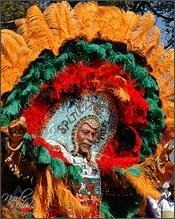 create and pay for the Mardi Gras parades throughout Louisiana. Mardi Gras krewes in New Orleans sponsor all the parades on Mardi Gras day such as the the Krewe of Rex, the Krewe of Zulu and the massive truck parades, the Krewes of Crescent City and Elks Orleanians that follow the Rex parade on Mardi Gras day. The Krewe of Zulu is the oldest annual African American parade in the country and famous for handing out the most valued of all Mardi Gras throws, the beautifully decorated Zulu Coconut. Mardi Gras krewes also sponsor parades throughout the New Orleans area in the days leading up to Mardi Gras Day. create and pay for the Mardi Gras parades throughout Louisiana. Mardi Gras krewes in New Orleans sponsor all the parades on Mardi Gras day such as the the Krewe of Rex, the Krewe of Zulu and the massive truck parades, the Krewes of Crescent City and Elks Orleanians that follow the Rex parade on Mardi Gras day. The Krewe of Zulu is the oldest annual African American parade in the country and famous for handing out the most valued of all Mardi Gras throws, the beautifully decorated Zulu Coconut. Mardi Gras krewes also sponsor parades throughout the New Orleans area in the days leading up to Mardi Gras Day.
Mardi Gras Marching Clubs and Mardi Gras Indians have no floats or designated routes. Parades of colorful Mardi Gras Indians and Mardi Gras marching clubs meander through the streets of New Orleans on Mardi Gras day. The costumed members dance through the streets with their accompanying jazz bands following no particular route other than to stop in their favorites bars along the way.
Mardi Gras Indians
The most elaborate costumes worn at Mardi Gras belong to the Mardi Gras Indians. The beautiful hand beaded costumes are created each year from scratch by members of the New Orleans Mardi Gras Indian organizations called tribes. New Orleans is home to about forty Mardi Gras Indian ‘tribes’. Members of the tribes are African Americans who consider their Mardi Gras Indian traditions to be a tribute to American Indians who aided runaway slaves. The colorful Mardi Gras 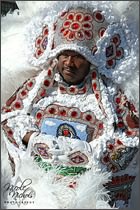 Indian costumes are called suits and are hand made by each Mardi Gras Indian with assistance from family and friends. No suit is reused. Each year, every Mardi Gras Indian makes a completely new suit complete with thousands of beads and feathers. Each Mardi Gras, the tribes parade through the streets of New Orleans. Tribal members include the Chief, Spy Boy, Flag Boy and others who seek to show dominance over other Mardi Gras Indian tribes by having the best display of suits, songs and dances. Mardi Gras Indian songs and rhythms have worked their way into the larger New Orleans music scene with songs like ‘Iko Iko’ becoming a New Orleans standard. Mardi Gras Indian tribes such as the Wild Magnolias and the Wild Tchoupitoulas have become as well known in New Orleans Mardi Gras culture as Rex, the traditional King of Carnival. Indian costumes are called suits and are hand made by each Mardi Gras Indian with assistance from family and friends. No suit is reused. Each year, every Mardi Gras Indian makes a completely new suit complete with thousands of beads and feathers. Each Mardi Gras, the tribes parade through the streets of New Orleans. Tribal members include the Chief, Spy Boy, Flag Boy and others who seek to show dominance over other Mardi Gras Indian tribes by having the best display of suits, songs and dances. Mardi Gras Indian songs and rhythms have worked their way into the larger New Orleans music scene with songs like ‘Iko Iko’ becoming a New Orleans standard. Mardi Gras Indian tribes such as the Wild Magnolias and the Wild Tchoupitoulas have become as well known in New Orleans Mardi Gras culture as Rex, the traditional King of Carnival.
Mardi Gras parades begin the second weekend before Mardi Gras day. 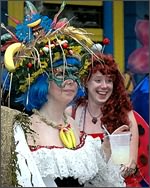 Each year about fifty Mardi Gras krewes parade through the streets of the New Orleans metropolitan area during the twelve day parade season culminating on Mardi Gras day. Two of the largest parades during the parade season or Carnival time as it’s well known, are the Krewes of Bacchus and Endymion. These two ‘super’ parades are best known for their huge extravagant floats and celebrity guest riders. Celebrities from Bob Hope to John Goodman have been kings of the Bacchus parade. The Endymion parade also has celebrity guest riders and hosts the city’s largest invitation only Mardi Gras party after the parade. Each year about fifty Mardi Gras krewes parade through the streets of the New Orleans metropolitan area during the twelve day parade season culminating on Mardi Gras day. Two of the largest parades during the parade season or Carnival time as it’s well known, are the Krewes of Bacchus and Endymion. These two ‘super’ parades are best known for their huge extravagant floats and celebrity guest riders. Celebrities from Bob Hope to John Goodman have been kings of the Bacchus parade. The Endymion parade also has celebrity guest riders and hosts the city’s largest invitation only Mardi Gras party after the parade.
Meet the people and the organizations behind  Mardi Gras. Browse the websites of the Mardi Gras Krewes from New Orleans and around Louisiana. Includes websites for marching clubs and Mardi Gras Indians. Mardi Gras. Browse the websites of the Mardi Gras Krewes from New Orleans and around Louisiana. Includes websites for marching clubs and Mardi Gras Indians.
Go to Mardi Gras Krewes, Mardi Gras Indians and Mardi Gras Parades
For Parade Schedules and Parade Routes
Go to Mardi Gras Guides
Krewe of Zulu
One of the oldest Mardi Gras organizations, the origins and traditions of Zulu are still a mystery to 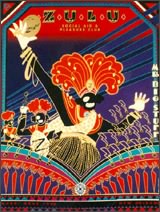 many locals and lovers of Mardi Gras. The Zulu organization began in 1909 as the Zulu Social Aid and Pleasure Club. The Zulu club was one of many benevolent organizations popular in black communities for providing financial help to sick members and burials for deceased members. The Zulus first marched through the streets of New Orleans on Mardi Gras in 1909 with William Story as the first King Zulu. The most notable King of Zulu was Louis Armstrong in 1949. many locals and lovers of Mardi Gras. The Zulu organization began in 1909 as the Zulu Social Aid and Pleasure Club. The Zulu club was one of many benevolent organizations popular in black communities for providing financial help to sick members and burials for deceased members. The Zulus first marched through the streets of New Orleans on Mardi Gras in 1909 with William Story as the first King Zulu. The most notable King of Zulu was Louis Armstrong in 1949.
Once limited by segregation to parading only in the black neighborhoods, today, Zulu is the ‘must see’ New Orleans Mardi Gras parade while the Zulu coconut or ‘golden nugget’ is the most prized of all Mardi Gras throws. Hundreds of feature stories and photo essays about the Zulus have been done by international publications. However, the Zulu organization hasn’t always been well received by those outside Louisiana and not familiar with the New Orleans Mardi Gras culture. During the 1960s, Zulu was nearly a victim of political correctness. Organizations around the country protested Zulu members for wearing blackface and grass skirts as part of their traditional costumes. Many saw the Zulu traditions as demeaning. Zulu membership dwindled to just 16 members and New Orleans was in danger of loosing its only African American sponsored parade.
The Zulu Social Aid and Pleasure Club hung on through the political controversies and came back stronger than ever. Membership has skyrocketed and now includes mayors and congressmen as well as members of all walks of life from laborers to business leaders. The Zulu organization is well known in the New Orleans community for its work with local schools and charities.
 |
|
|
|
Many New Orleans photos courtesy of New Orleans photographer Nicole Nichols Photography
|
|
|
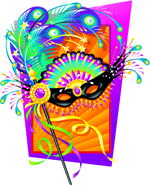 |
|
|
 |
 |
|
Mardi Gras around Louisiana
Mardi Gras is celebrated in cities and towns throughout Louisiana. Mardi Gras is a Catholic tradition so Mardi Gras celebrations are most common in south Louisiana which has the largest Catholic population in the state. Mardi Gras is a family celebration in 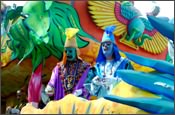 Louisiana although New Orleans is best known by tourists and the rest of the country for the raucous Carnival celebrations in the French Quarter. The further you go from the French Quarter, the more family oriented the celebrations become. Tourists are always welcome at any Mardi Gras celebration anywhere in Louisiana but should not expect the kind of adult entertainment that is common in the French Quarter on Mardi Gras day. Louisiana although New Orleans is best known by tourists and the rest of the country for the raucous Carnival celebrations in the French Quarter. The further you go from the French Quarter, the more family oriented the celebrations become. Tourists are always welcome at any Mardi Gras celebration anywhere in Louisiana but should not expect the kind of adult entertainment that is common in the French Quarter on Mardi Gras day.
The Cajun Capital of Lafayette is home to the second largest Mardi Gras celebration in Louisiana. Celebrating Mardi Gras since 1869, Mardi Gras in Lafayette is celebrated by 250,000 revelers each year. The king and queen of Mardi Gras in Lafayette are known as King Gabriel and Queen Evangeline, named for the hero and heroine of Henry Wadsworth Longfellow's epic poem, ‘Evangeline’.
Lake Charles, in south Louisiana near the Texas border, first began formal Mardi Gras celebrations in 1882. Lake Charles has nine Mardi Gras parades each year with over 50 Mardi Gras krewes and over 150,000 revelers each year. Only New Orleans has more Mardi Gras krewes than Lake Charles.
Houma, a Cajun town 60 miles south of New Orleans, has been celebrating Mardi Gras formally since 1947 and has eleven Mardi Gras parades beginning two weekends before Mardi Gras day. About 150,000 revelers attend the annual Mardi Gras celebrations in Houma.
Courir de Mardi Gras
Deep in Cajun country, the oldest Mardi Gras traditions, dating back to medieval Europe, are celebrated. Centuries before the days of organized parades and Mardi Gras balls, Mardi Gras in Catholic Europe was an informal street celebration. Medeval peasants donned costumes mimicking royalty and church hierarchy and reveled freely in the streets and countryside uninhibited by strict medieval cultural norms. Directly descended from these celebrations is the Courir de Mardi Gras of the Cajuns. The Courir de Mardi Gras (Fat Tuesday Run in French) is similar to an adult ‘trick or treat’. In small Cajun towns such as Mamou, Eunice and Basile, masked costumed revelers on horseback led by Le Capitaine, ride through the countryside going from farmhouse to farmhouse collecting ingredients for a large traditional communal meal such as Cajun gumbo. The masked riders will sing traditional songs, dance and beg for ingredients for the communal meal. The music, dancing, alcohol and antics such as chasing down live chickens tossed to them from the farmhouse create a truly unique rural celebration seen nowhere else in America.
There are many other Mardi Gras celebrations in small towns and cities throughout Louisiana including Shreveport, Baton Rouge, Metairie, Gretna, Alexandria, Thibodaux, Mandeville, La Place, Slidell, Natchitoches, New Roads, Monroe and Bogalusa.
Mardi Gras History
Mardi Gras, French for ‘Fat Tuesday’, is a Catholic European tradition dating back at least to medieval times. The term was originally, and  is still known as, Carnival, which comes from the Latin phrase for ‘goodbye to the flesh’. In English it is known as Shrove Tuesday. It refers to the tradition of eating rich fatty foods on the Tuesday before Ash Wednesday, the beginning of the forty days of Lent and fasting before Easter in the Catholic tradition. To determine when Mardi Gras takes place, simply back up forty days before Easter on the calendar. The Carnival celebration over the centuries incorporated many festivities including street celebrations with music, dancing, parades and wearing costumes and masks. is still known as, Carnival, which comes from the Latin phrase for ‘goodbye to the flesh’. In English it is known as Shrove Tuesday. It refers to the tradition of eating rich fatty foods on the Tuesday before Ash Wednesday, the beginning of the forty days of Lent and fasting before Easter in the Catholic tradition. To determine when Mardi Gras takes place, simply back up forty days before Easter on the calendar. The Carnival celebration over the centuries incorporated many festivities including street celebrations with music, dancing, parades and wearing costumes and masks.
Mardi Gras or Carnival season in Catholic cities around the world that celebrate it traditionally begins on Epiphany or Twelfth Night, twelve days after Christmas. The celebrations slowly escalate to the grand finale on Fat Tuesday, Mardi Gras day. Although most Carnival celebrations have died out, even in Catholic cities around the world, there are many cities that still carry on Carnival celebrations. The most famous of these are Rio de Janeiro in Brazil and New Orleans. Mardi Gras, or Carnival is also still celebrated to some extent in Latin America, Belgium, Canada, particularly in Catholic Quebec, Germany, the Netherlands, Sweden and even Australia.
The Carnival festivities that are so well known in New Orleans, originated in Italy. The Italians had taken the Carnival celebrations to new heights with several weeks of celebrations leading to Martedí Grasso (Italian for Fat Tuesday). The French incorporated the Italian traditions of masked balls, parades and pageants into their own Carnival celebrations before eventually bringing it to their colonies in French Louisiana and the Gulf Coast. Although Mardi Gras celebrations are largely extinct in France, a victim of the French Revolution and its suppression of religious celebrations, Mardi Gras survived in the French colonies.
Mardi Gras in America is a Gulf Coast celebration. Mardi Gras Day is celebrated from Galveston, Texas (since 1867) to Pensacola, Florida (since 1874). The French settled all along the Gulf Coast bringing their Catholic traditions and celebrations with them. Mardi Gras was first celebrated in America in 1703 in Mobile, Alabama. Mobile had been founded the year before by the same French explorer that founded New Orleans in 1718, Jean-Baptiste Le Moyne de Bienville. Mobile also has the oldest formal Mardi Gras organizations dating from 1830. In Mobile, the secret Mardi Gras organizations are known as ‘mystic societies’, the counterpart to krewes in New Orleans. As in New Orleans and elsewhere, mystic societies or krewes are the organizations that organize and produce the elaborate parades that Mardi Gras is so well known for. In 1830, the first Mardi Gras parade in America took place in Mobile with marching revelers and by 1840, Mobile parades included horse-drawn floats.
By the 1850s the old French Creole tradition of celebrating Mardi Gras in New Orleans was fading as the original French Creole population was being displaced by Anglo-Americans and other immigrants to the city. However, in 1856, six businessmen from Mobile, who had recently relocated to New Orleans, gathered in a room above a restaurant in the French Quarter and founded the first formal Mardi Gras organization in New Orleans, the Mystic Krewe of Comus. Like the names of many New Orleans Mardi Krewes to come, the name Comus had mythical origins. The following year, in 1857, the Mystic Krewe of Comus produced the first formal Mardi Gras parade in New Orleans.
The first Comus parade was so popular that that by the second year, thousands of out of towners had come to New Orleans to enjoy the celebration with many dozens of new Mardi Gras krewes to be formed in the coming years.
Meet the people and the organizations behind  Mardi Gras. Browse the websites of Mardi Gras Krewes and parades from New Orleans, around Louisiana and the Gulf Coast and beyond. Mardi Gras. Browse the websites of Mardi Gras Krewes and parades from New Orleans, around Louisiana and the Gulf Coast and beyond.
Go to Mardi Gras Krewes
For Parade Schedules and Parade Routes
Go to Mardi Gras Guides
|
|